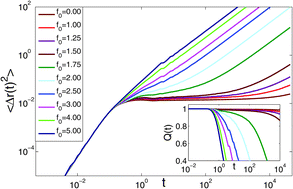Active fluidization in dense glassy systems
Abstract
Dense soft glasses show strong collective caging behavior at sufficiently low temperatures. Using molecular dynamics simulations of a model glass former, we show that the incorporation of activity or self-propulsion, f0, can induce cage breaking and fluidization, resulting in the disappearance of the glassy phase beyond a critical f0. The diffusion coefficient crosses over from being strongly to weakly temperature dependent as f0 is increased. In addition, we demonstrate that activity induces a crossover from a fragile to a strong glass and a tendency of active particles to cluster. Our results are of direct relevance to the collective dynamics of dense active colloidal glasses and to recent experiments on tagged particle diffusion in living cells.


 Please wait while we load your content...
Please wait while we load your content...